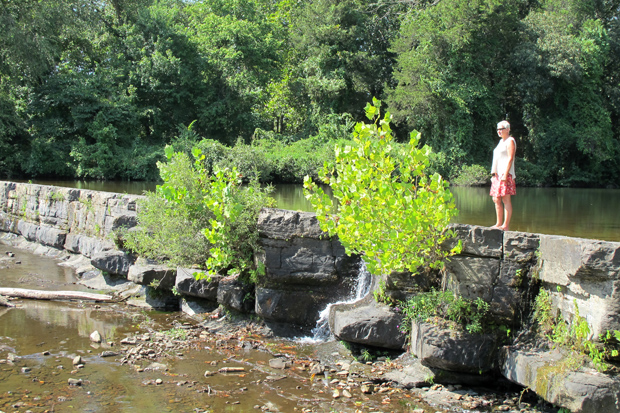
Debbie Doss, conservationist for the Arkansas Canoe Club, stands on Natural Dam a few hundred feet upstream from Lee Creek in northwest Arkansas.
Logan Layden / StateImpact Oklahoma


Debbie Doss, conservationist for the Arkansas Canoe Club, stands on Natural Dam a few hundred feet upstream from Lee Creek in northwest Arkansas.
Logan Layden / StateImpact Oklahoma

Logan Layden / StateImpact Oklahoma
Debbie Doss picks up garbage and loose clothing left behind by careless tourists along Lee Creek.
This is part three of StateImpact Oklahoma’s four-part series on the history of Oklahoma’s scenic rivers and the environmental threats they face. Part two is available here.
A narrow rock wall holds back all but a couple of tiny waterfalls that sneak through cracks and flow into Lee Creek. This natural dam is so unique a nearby town in northwest Arkansas was named for it.
Eventually, Lee Creek becomes one of Oklahoma’s scenic rivers — where it’s known as Big Lee’s Creek, or simply Lee’s Creek — as it wends its way along the border with Arkansas. To the north, headquarters for Wal-Mart, J.B. Hunt Trucking, Tyson Food, among others. To the south, Fort Smith and Van Buren, growing cities in their own right.
Updates to municipal water systems in northwest Arkansas and pressure on the poultry industry to control the discharge of chicken waste have meant water quality improvements for streams and creeks in eastern Oklahoma, but it remains to be seen whether efforts to preserve the environmentally important and economically vital rivers can keep up with one of the fastest growing regions of the country.
“All of these gains that we’ve made could be overcome pretty quickly,” Ed Fite with the Oklahoma Scenic Rivers Commission says. “In 1983, when I arrived at the Scenic Rivers Commission, the population in the entire Illinois River Basin, Arkansas and Oklahoma, was under 200,000 individuals. Today it’s 600,000 people. So in 35 years we could be at 1.1, 1.2 million people.”
Fite says the biggest threat facing Oklahoma’s scenic rivers in the future is the development that comes with all that growth in Arkansas and northeast Oklahoma. Lee’s Creek in particular does not recognize the differences between the two states as it snakes along the border.
Debbie Doss, the conservationist for the Arkansas Canoe Club says the word is out: northwest Arkansas is a great place to live. But that’s a two-sided coin.
“People come to an area like this because it’s so beautiful,” she says. “You know, we start to love it to death. And we lose the qualities that we came here for in the first place.”
The growth is welcome. It means jobs and opportunity, but the outdoors is big business here, too, and balancing the economic boom with efforts to preseve the scenic beauty that fuels tourism presets a considerable challenge.
“Agriculture, municipal runoff of fertilizer, animal feeding operations — chicken, pigs, hogs, cattle — all contribute to the nutrients in our streams, and the nutrients are those chemicals that cause the overgrowth of algae,” Doss says.

Logan Layden / StateImpact Oklahoma
Debbie Doss, conservationist for the Arkansas Canoe Club, stands on Natural Dam a few hundred feet upstream from Lee Creek in northwest Arkansas.
Add to that the ‘property fragmentation’ of what have traditionally been large farms as their owners die off.
“Another problem is that most of these ancestral farms are not taken on by the children. They’re sold off and parceled up into housing developments and business and industries,” Doss says. “And then you have those kinds of things right on the bank of the river.”
Growth of population and industry also requires more infrastructure: highways and streets and bridges, which all can lead to more sediment runoff into the rivers.
“And that’s from construction — road construction more than anything else is causing this problem,” Doss says. “It kills fish. It completely changes the biota of the stream from beautiful game fish that we all like to fish, bass and crappie, and all those things are disturbed and made unhealthy by sediment and nutrients — and they’re replaced by things like catfish.”
Development and road construction shows no sign of slowing in the Oklahoma/Arkansas border region. Soon, construction on the final stretch of the new Interstate 49 will be complete and provide a straight shot from Winnipeg, Canada, to New Orleans, right through western Arkansas, just a few miles from the Oklahoma border.